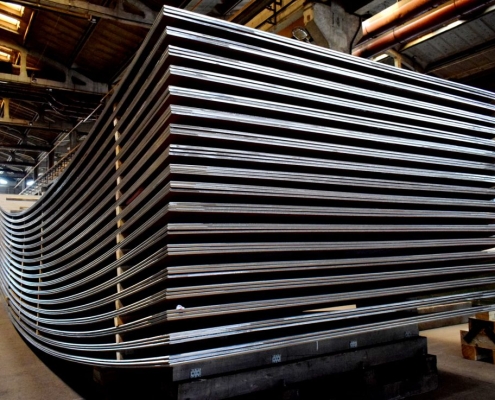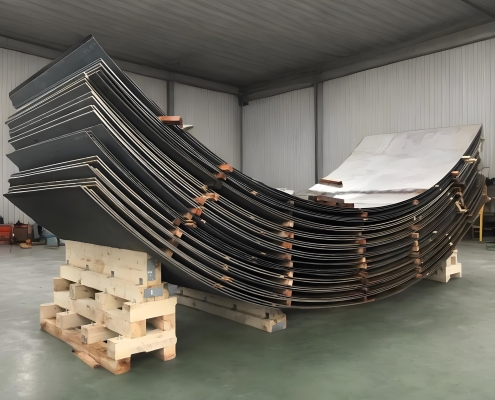Future Energy Steel offers premium and tailored Steel Plate for Oil Storage Tanks, meticulously engineered to meet rigorous industry standards like API 650. Our selection features a variety of grades like ASTM A36, JIS G3101 SS400, and ASTM A283 Gr.C optimized for durability, corrosion resistance, and structural integrity, ensuring dependable performance in oil storage facilities. Key attributes include high tensile strength, excellent weldability, and superior impact resistance, essential for maintaining tank integrity and safety. We provide comprehensive services, including customized cutting, testing, and efficient logistics solutions, all underpinned by our steadfast commitment to quality assurance. Whether for crude oil, refined products, or chemicals, Future Energy Steel delivers the ideal solution for ensuring your oil storage operations’ long-term reliability and efficiency. For more details, please contact us at [email protected].
FAQs
What Are Steel Plates for Oil Storage Tanks?
Steel plates for oil storage tanks are specialized structural components used in constructing above-ground and underground tanks designed to store various petroleum products, chemicals, and other liquids. These plates are essential for ensuring oil storage facilities’ structural integrity, safety, and longevity. Key features and characteristics of steel plates for oil storage tanks include:
High Strength: Steel plates used for oil storage tanks are designed to withstand the weight of stored liquids and the structural loads exerted by the tank’s contents. They provide sufficient strength and durability to support the tank’s structure over its service life.
Corrosion Resistance: Oil storage tanks are exposed to potentially corrosive substances, including crude oil, refined products, and chemicals. Steel plates used in tank construction may be made from corrosion-resistant alloys or coated with protective materials to prevent corrosion and extend the tank’s service life.
Weldability: Weldability is crucial for fabricating steel plates into tank components such as shell, bottom, and roof plates. Steel plates must have good weldability to ensure strong, leak-proof weld joints that maintain the tank’s structural integrity.
Dimensional Accuracy: Steel plates for oil storage tanks are manufactured to precise dimensional tolerances to ensure proper fit and alignment during tank assembly. Accurate dimensions are essential for maintaining the tank’s structural integrity and preventing leakage.
API Standards: Steel plates for oil storage tanks often comply with standards set by the American Petroleum Institute (API), such as API 650 for welded steel tanks for oil storage. API 650 specifies requirements for the design, fabrication, erection, and testing of welded steel tanks for storing petroleum products.
Pressure and Temperature Resistance: Steel plates may be selected to withstand specific pressure and temperature ranges without deformation or failure, depending on the type of stored liquid and operational conditions.
Inspection and Testing: Steel plates used in oil storage tanks undergo rigorous inspection and testing procedures to ensure they meet quality and safety standards. This includes testing for mechanical properties, weldability, corrosion resistance, and dimensional accuracy.
Steel plates for oil storage tanks play a critical role in the oil and gas industry by providing secure and reliable storage solutions for liquid products. Their quality and performance directly impact oil storage facilities’ safety, environmental protection, and operational efficiency worldwide.
Which Steel Plate is Used to Build Oil Storage Tanks?
Steel plates used to build oil storage tanks are selected based on several critical factors, including the type of liquid being stored, tank design specifications, environmental conditions, and regulatory requirements. The primary types of steel plates used for constructing oil storage tanks include:
Carbon Steel Plates: Carbon steel plates are widely used in the construction of oil storage tanks due to their affordability, availability, and good mechanical properties. They provide sufficient strength and toughness for most tank applications and are suitable for storing crude oil and various refined petroleum products.
Low-Alloy Steel Plates: Low-alloy steel plates, such as those with added elements like manganese, nickel, chromium, or molybdenum, offer enhanced mechanical properties compared to carbon steel. Depending on the specific application and environmental conditions, they may be used in oil storage tanks requiring higher strength, impact resistance, or corrosion resistance.
Corrosion-Resistant Steel Plates: Corrosion-resistant steel plates are essential for oil storage tanks exposed to corrosive substances or environments (e.g., saltwater, chemicals). These plates may include alloyed steel grades or be coated with corrosion-resistant materials to prevent degradation and extend the tank’s service life.
Duplex and Super Duplex Stainless Steels: Duplex stainless steels, such as ASTM A240/A240M UNS S32205 and super duplex stainless steels, offer excellent corrosion resistance and high strength, making them suitable for storing corrosive liquids or operating in aggressive environments.
API Specified Steel Plates: The American Petroleum Institute (API) specifies specific grades of steel plates for oil storage tanks under API 650 (welded steel tanks for oil storage) and API 620 (design and construction of large, welded, low-pressure storage tanks). These standards ensure that steel plates meet specific mechanical properties, weldability requirements, and safety criteria for storing petroleum products.
High-Strength Low-Alloy (HSLA) Steel Plates: HSLA steel plates provide higher strength-to-weight ratios than conventional carbon steel plates. They are used in oil storage tanks where reducing weight or material usage is critical while maintaining structural integrity and durability.
The selection of steel plates for oil storage tanks is based on factors such as tank size, operational conditions (including temperature and pressure), liquid contents, environmental factors (such as corrosion potential), and regulatory standards. Engineers and tank designers carefully choose the appropriate type and grade of steel plates to ensure the safety, reliability, and long-term performance of oil storage tanks in the oil and gas industry.
What Are the Standards for Steel Plates for Oil Storage Tanks?
Steel plates used for oil storage tanks must comply with stringent standards to meet safety, reliability, and environmental requirements for storing petroleum products. Some of the key standards governing steel plates for oil storage tanks include:
ASTM A36: ASTM A36 is a versatile carbon steel plate suitable for various structural applications, including storage tanks. Its moderate strength and good weldability make it ideal for constructing tanks that store liquids or gases under atmospheric conditions.
ASTM A283 Gr.C: ASTM A283 Grade C is a low—and intermediate-tensile-strength carbon steel plate for storage tank construction. It offers good formability and weldability, making it suitable for moderate to lower-temperature service.
JIS G3101 SS400: JIS G3101 SS400 is a Japanese standard for general structural steel, including hot-rolled steel plates. Its high strength and good weldability make it suitable for constructing storage tanks where moderate strength and toughness are required.
ASTM A572: ASTM A572 is a high-strength, low-alloy structural steel specification suitable for storage tank plates. It offers excellent mechanical properties, including higher strength, and is used in applications where weight savings and increased durability are essential.
ASTM A573: ASTM A573 is a specification for structural quality carbon-manganese-silicon steel plates suitable for storage tank applications. It provides improved toughness and weldability compared to basic carbon steel plates, making it ideal for tanks requiring enhanced performance under atmospheric conditions.
These standards define requirements for steel plate dimensions, chemical composition, mechanical properties (such as yield strength, tensile strength, and impact toughness), welding procedures, non-destructive testing (NDT), and quality assurance practices. Compliance with these standards ensures that steel plates used in oil storage tanks meet industry-specific safety, performance, and environmental protection requirements. Engineers and tank manufacturers carefully select and specify steel plates based on these standards to ensure the reliability and longevity of oil storage tanks in the oil and gas industry.
What Processes Are Applied to the Steel Plates for Oil Storage Tanks?
Steel plates used for oil storage tanks undergo various processes to meet quality, durability, and performance requirements for storing petroleum products and chemicals. Key processes applied to these steel plates include:
Hot Rolling: Steel plates are initially produced through hot rolling, where steel ingots or slabs are heated above their recrystallization temperature and passed through rollers to achieve the desired thickness and dimensions. Hot rolling improves the mechanical properties of the steel plates, such as strength and toughness.
Normalization: Some steel plates may undergo normalization, a heat treatment process that involves heating the plates to a temperature above the critical range and then cooling them in still air. This process refines the grain structure, improves uniformity, and enhances the mechanical properties of the plates, making them suitable for welding and forming into tank components.
Shot Blasting: Shot blasting is a surface preparation process where steel plates are bombarded with tiny metal particles (shots) at high velocity to clean the surface from mill scale, rust, and other contaminants. Shot blasting improves the adhesion of coatings and enhances the surface finish of the plates.
Cutting and Profiling: Steel plates are cut to size and profiled according to specific tank design requirements using plasma, laser, or mechanical cutting methods. This ensures the plates fit accurately during tank assembly and fabrication.
Forming and Bending: Steel plates may undergo forming and bending processes to shape them into curved or cylindrical sections required for tank components such as shells, heads, and bottoms. These processes are carefully controlled to prevent deformation and maintain dimensional accuracy.
Welding: Welding is a critical process in the fabrication of oil storage tanks, where steel plates are joined together using various welding techniques, such as submerged arc welding (SAW), gas metal arc welding (GMAW), or shielded metal arc welding (SMAW). Welding procedures must comply with specific standards and procedures to ensure strong, leak-proof joints that maintain the tank’s structural integrity.
Surface Treatment and Coating: Steel plates for oil storage tanks may undergo surface treatment and coating processes to enhance corrosion resistance and protect against environmental factors. This may include applying primers, epoxy coatings, or specialized corrosion-resistant coatings that withstand exposure to corrosive liquids and atmospheric conditions.
Quality Control and Testing: Steel plates undergo rigorous quality control measures and testing procedures throughout the manufacturing process. This includes dimensional inspection, mechanical testing (such as tensile testing and impact testing), non-destructive testing (NDT) methods (such as ultrasonic testing and radiographic testing), and chemical analysis to ensure they meet specified standards and performance requirements.
These processes ensure that steel plates used in oil storage tanks are fabricated to high-quality standards, providing durability, reliability, and long-term performance in safely and efficiently storing petroleum products and chemicals.
Are the Steel Plates for Oil Storage Tanks Coated and What Are the Coating Brands?
Steel plates used for oil storage tanks are often coated to enhance their corrosion resistance and durability in harsh environments. The choice of coating depends on factors such as the type of tank, the stored material, environmental conditions, and regulatory requirements. Some standard coatings used for steel plates in oil storage tanks include:
Epoxy Coatings: Epoxy coatings provide excellent corrosion resistance and are commonly used for both internal and external surfaces of oil storage tanks. They offer good adhesion to steel substrates and can withstand exposure to petroleum products and atmospheric conditions.
Polyurethane Coatings: Polyurethane coatings are known for their durability and resistance to abrasion, chemicals, and weathering. They are suitable for external tank surfaces exposed to UV radiation and harsh weather conditions.
Zinc Coatings: Zinc coatings, such as hot-dip galvanizing or zinc-rich paint, provide sacrificial corrosion protection to steel plates. They are effective in preventing corrosion caused by moisture and atmospheric exposure.
Fusion-Bonded Epoxy (FBE): FBE coatings are applied using heat to fuse the coating material onto the steel surface. They provide excellent adhesion and corrosion resistance, making them suitable for internal and external tank applications.
Polymeric Linings: Polymeric linings, such as polyethylene (PE) or polypropylene (PP) linings, are used for internal tank surfaces to prevent corrosion and contamination of stored liquids. These linings offer chemical resistance and are suitable for tanks storing aggressive fluids.
Bitumen Coatings: Bitumen coatings provide corrosion protection and water resistance, primarily used for external tank surfaces in harsh environments.
Corrosion Inhibiting Coatings: Specialty coatings with corrosion inhibitors are sometimes applied to steel plates to extend the service life of oil storage tanks and minimize maintenance requirements.
The coating brand or manufacturer choice depends on project specifications, performance requirements, and compatibility with the stored liquids. Major coating brands and manufacturers in the industry include but are not limited to:
PPG Industries
Sherwin-Williams
AkzoNobel
Axalta Coating Systems
Jotun
Hempel
International Paint
These companies offer a range of coating systems designed to meet specific industry standards, regulatory requirements, and performance criteria for oil storage tanks. The selection of the appropriate coating system is crucial to ensure long-term protection, reliability, and safety of oil storage facilities.
Can the Steel Plates for Oil Storage Tanks be Bent?
Yes, steel plates used for oil storage tanks can be bent and formed to achieve specific shapes and configurations required for tank construction. The ability to bend steel plates depends on several factors, including the plate thickness, material grade, and manufacturing processes. Here are key points regarding the bending of steel plates for oil storage tanks:
Plate Thickness: Thinner steel plates are generally more easily bent than thicker plates. A plate’s bending capacity increases with its thickness up to a certain limit, beyond which specialized equipment may be required.
Material Grade: The material grade of the steel plate influences its formability and bendability. Higher strength grades may require preheating or controlled rolling processes to optimize formability and prevent cracking during bending.
Manufacturing Processes: Steel plates for oil storage tanks are often produced using controlled rolling, thermomechanical rolling, or normalized processes to enhance their mechanical properties and formability. These processes help achieve uniform grain structure and minimize internal stresses, which can affect the plate’s ability to be bent without cracking.
Bending Techniques: Steel plates can be bent using various techniques, including cold and hot bending. Cold bending is typically used for thinner plates and involves bending at room temperature using press brakes or rollers. Hot bending involves heating the plate to a specific temperature range to increase its ductility before bending.
Bending Radius and Limits: The minimum bending radius and maximum bend angle depend on the plate thickness, width, and the specific bending equipment. Manufacturers and fabricators adhere to industry standards and guidelines to ensure the integrity and quality of bent steel plates.
Post-Bending Considerations: After bending, steel plates may require additional processes, such as stress relieving or flattening, to ensure dimensional accuracy and remove residual stresses that could affect the tank’s structural integrity.




